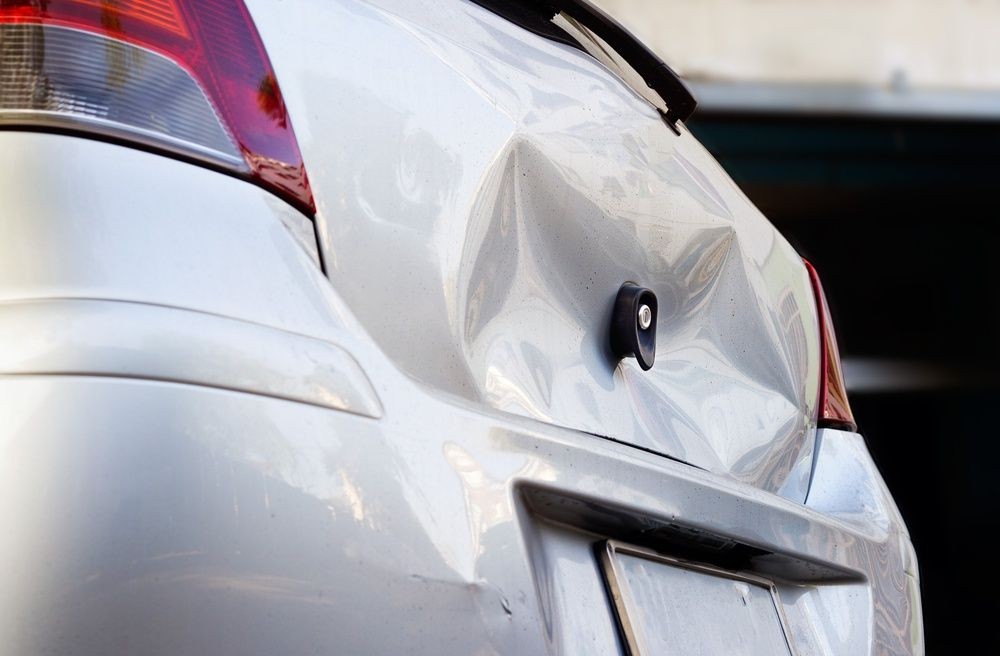Discovering a dent in your car door can be frustrating, whether it happened in a car park, or due to unexpected debris. One of the first questions that springs to mind is: how much to repair a dented car door in the UK? Understanding the costs involved is crucial before deciding on the best course of action.
This comprehensive guide will walk you through the typical expenses associated with car door dent repair in the UK. We’ll explore various factors that influence the price, the different repair methods available, and help you determine whether fixing that dent is the right decision for you and your wallet.
Is Fixing a Dented Car Door Worth It?
Deciding whether to repair a dented car door often boils down to a balance between cost, your budget, and the overall condition of your vehicle. If you are driving an older car with existing wear and tear, a small dent might not be a priority. However, for newer vehicles or if you’re planning to sell or trade-in your car, addressing the damage becomes more important.
Consider these factors:
- Severity of the Dent: Minor dings might be less urgent, while larger, deeper dents, or those affecting door functionality, should be addressed promptly.
- Car’s Age and Condition: For an older car, cosmetic imperfections might be less concerning. For newer cars, maintaining pristine condition is usually preferred.
- Potential for Further Damage: Leaving a dent unrepaired could lead to rust or further complications, especially if the paint is cracked, potentially increasing repair costs in the long run.
- Resale Value: As we’ll discuss later, dents can significantly decrease your car’s resale value.
Ultimately, if the dent is minor and doesn’t bother you, it might be economical to leave it. However, for significant dents or if you value your car’s appearance and future resale value, repair is generally recommended.
Understanding the Cost to Fix a Dented Car Door
The cost to repair a dented car door in the UK can vary widely. A small, shallow dent might be fixed for as little as £50, especially with paintless dent repair techniques. However, more extensive damage, dents in difficult-to-reach areas, or dents requiring traditional repair methods and repainting can significantly increase the price. In some cases, the repair cost might approach or even exceed the cost of replacing the entire car door, particularly if there’s additional damage like scratches or paint damage.
Let’s delve into the average costs you can expect.
Average Car Door Dent Repair Costs in the UK
On average, you can expect to pay between £220 and £450 per panel for car dent repair in the UK. This is a general range, and the actual cost will depend on several key variables:
- Size and Depth of the Dent: Larger and deeper dents naturally require more work and potentially more materials, increasing the cost.
- Location of the Dent on the Panel: Dents in easily accessible, flat areas are simpler and cheaper to repair. Dents on edges, curves, or reinforced areas are more complex and costly.
- Make and Model of the Car: Some car makes and models have more complex body panels or require specific paint types, which can affect repair costs.
- Accessibility of the Dent: If the dent is difficult to reach, requiring dismantling of interior panels or other components, labour costs will increase.
- Paint Damage: If the dent has caused scratches, chips, or cracks in the paint, repainting will be necessary, adding significantly to the overall cost.
- Your Location in the UK: Labour rates for car body repair shops can vary across different regions in the UK.
Alt: Table showing average car dent repair costs in the UK, including paint scratches, bumper repair, and paintless dent removal.
Breakdown of Average Car Dent Repair Costs
To give you a clearer picture, here’s a table outlining ballpark average costs for different types of car dent repairs in the UK:
| Type of Car Dent | Average Cost (per panel) |
|---|---|
| Clear-coat scratches | £78 |
| Paint scratches and scuffs | £150 |
| Deep paint scratches | £210 |
| Bumper repair costs (per hour) | £60 |
| Bumper repair costs (fixed fee) | £810 |
| Car dent repair costs (per panel) | £335 |
| Paintless dent removal (per panel) | £220 |



Note: These are average costs and can vary based on the factors mentioned above. Always get a specific quote from a repair professional.
Will a Dent Reduce My Car’s Value?
Yes, unfortunately, dents almost certainly decrease your car’s value. A car with visible dents is generally perceived as less desirable by potential buyers. It’s estimated that dents can depreciate a car’s value by 5% to 10%. This can have a significant impact, especially on newer or higher-value vehicles.
When you consider selling or trading in your car, even minor dents and dings can accumulate and negatively affect its overall appraisal. Buyers may assume that cosmetic damage indicates underlying issues or neglect, leading them to offer a lower price.
Alt: Close-up of a noticeable dent on a white car door, illustrating typical car body damage.
Therefore, if you are concerned about maintaining your car’s resale value, especially if the dents are noticeable, investing in repairs is a worthwhile consideration. Getting a professional estimate for dent repair and comparing it to the potential depreciation can help you make an informed decision.
Dent Repair Options: Traditional vs. Paintless Dent Repair (PDR)
When it comes to repairing car door dents, you have two primary methods to choose from: traditional dent repair and paintless dent repair (PDR). Understanding the differences is key to selecting the best approach for your specific situation and budget.
Traditional Dent Repair
Traditional dent repair is the more established method, often employed for larger or more complex dents, or when the paint has been damaged. This process typically involves:
- Sanding down the damaged area: Removing paint and smoothing out the dented metal.
- Filling the dent: Using body filler to restore the original shape and contour of the panel.
- Sanding and shaping the filler: Ensuring a smooth, seamless surface that matches the surrounding panel.
- Priming and painting: Applying primer and then repainting the repaired area to match the car’s original colour. This often involves blending the new paint with the surrounding panels for a flawless finish.
Traditional dent repair is more labour-intensive and time-consuming than PDR, and consequently, it is generally more expensive. It’s necessary when the dent is deep, stretches the metal, or if the paint is cracked, scratched, or missing.
Paintless Dent Repair (PDR)
Paintless Dent Repair (PDR) is a more modern and increasingly popular technique, particularly effective for minor to moderate dents where the paint surface is intact. PDR offers a less invasive and often more cost-effective solution. The process involves:
- Accessing the dent: Technicians use specialized tools to carefully access the back side of the dented panel, often through existing openings or by removing lights or interior trim.
- Massaging the dent out: Using levers, rods, and picks, technicians gently massage and manipulate the metal from behind, gradually pushing the dent back to its original shape.
- Refining the repair: Tapping down any high spots and ensuring a smooth, seamless finish, often using specialized hammers and blending tools.
PDR is advantageous because it:
- Preserves the original paint: Avoiding the need for repainting maintains the factory finish, which can be beneficial for resale value.
- Is typically faster: PDR repairs are often completed in a few hours, compared to the days traditional repair might take.
- Is generally less expensive: Lower labour and material costs make PDR a more budget-friendly option for suitable dents.
PDR is best suited for:
- Smaller to medium-sized dents: Typically up to a few inches in diameter.
- Shallow to moderate depth dents: Dents that haven’t excessively stretched the metal.
- Dents with intact paint: PDR cannot repair paint damage; if the paint is cracked or scratched, traditional repair will likely be necessary.
Alt: Example of a car door dent after professional paintless dent repair, showing a smooth, damage-free surface.
Choosing between traditional dent repair and PDR depends on the specifics of your dent, your budget, and your priorities. A reputable car body repair shop can assess the damage and recommend the most appropriate and cost-effective method.
Paintless Dent Repair (PDR) Costs: A Closer Look
As mentioned earlier, Paintless Dent Repair (PDR) is generally more affordable than traditional methods. Starting prices for PDR in the UK are typically around £90 per panel. However, this is just a starting point, and several factors can influence the final cost:
- Material of the Body Panels: Aluminium panels, increasingly common in modern cars, can be more challenging to repair with PDR and may incur higher costs.
- Cause of the Dent: Sharp, pointed impacts might create more complex dents than broad, rounded impacts.
- Diameter and Depth of the Dent: Larger and deeper dents naturally require more time and skill, increasing the cost.
- Age and Condition of the Paint: Older or brittle paint might be more prone to cracking during PDR, requiring extra care and potentially increasing the risk (and cost).
- Temperature: Temperature can affect metal flexibility; extreme temperatures can sometimes impact PDR effectiveness or complexity.
- Paint Colour: Some paint colours, particularly metallic or multi-stage paints, can be more challenging to blend if touch-up is needed (though PDR aims to avoid repainting).
- Location of the Damage: Dents on body lines, edges, or areas with limited access will be more complex and thus more expensive to repair with PDR.
For multiple minor dents, such as bodyline scratches alongside a dent, you might expect to pay an additional £15–£45 per scratch.
PDR Costs for Hail Damage
Hail damage, which often results in multiple small dents across various panels, is a common application for PDR. For hail damage repair using PDR, you can expect an initial charge of around £45, plus approximately £20 for each additional dent on the same panel. The total cost will depend on the number of dents, their size and location, and the type of vehicle. Car insurance often covers hail damage, so it’s worth checking your policy.
How Long Does Car Dent Removal Take?
The duration of car dent removal depends significantly on the repair method and the complexity of the damage.
- Paintless Dent Repair (PDR): PDR is generally quite quick. For a single, straightforward dent, repairs can often be completed within two to five hours, allowing you to potentially get your car back on the same day. Minor dings and scratches might only take a couple of hours.
- Traditional Dent Repair: Traditional methods take considerably longer due to the multi-stage process of sanding, filling, priming, and painting. Repairs can take several days, especially for larger dents or when colour matching and blending are required.
More significant dents or those in awkward locations will naturally take longer to repair, regardless of the method. Always confirm the estimated repair time with the chosen repair shop when getting a quote.
Does a Dented Car Door Always Need Replacement?
Fortunately, a dented car door rarely needs to be replaced if the damage is primarily cosmetic and the door’s structural integrity is intact. Most dents, even fairly noticeable ones, can be effectively repaired using either traditional dent repair or paintless dent repair techniques.
In some cases, for very minor dents, you might even consider DIY dent removal kits available for home use, although caution and realistic expectations are advised.
However, door replacement might be considered if:
- The damage is extensive and structural: If the dent is extremely large, has severely warped the door frame, or damaged internal mechanisms like window regulators or locking systems.
- Corrosion or rust is significant: If the dent has been present for a long time and led to extensive rust or corrosion that compromises the door’s integrity.
- Repair costs are excessively high: In rare cases, if the damage is so complex and extensive that repair costs approach or exceed the cost of a new or salvaged door, replacement might be a more economical option.
In most dent scenarios, professional repair, not replacement, is the standard and recommended solution.
Will Car Insurance Cover Car Door Dents?
Whether your car insurance covers car door dents depends on the type of policy you have and the circumstances of the damage.
- Comprehensive Car Insurance: Comprehensive policies typically cover accidental damage, including dents, regardless of fault. If your dent is caused by an unknown event (like a runaway shopping trolley or hail), or if you are at fault in a minor incident, comprehensive cover should apply (subject to your excess).
- Collision Coverage: If the dent resulted from a collision with another vehicle or object, collision coverage (part of comprehensive or sometimes a separate option) would likely apply, regardless of fault.
- Third-Party, Fire, and Theft (TPFT): TPFT policies offer a more limited level of cover. They typically cover damage to your car caused by fire or theft, and liability to third parties, but usually do not cover accidental damage like dents unless caused by a third party who is identified and insured.
- Third-Party Only (TPO): TPO is the most basic level of cover and only covers your liability to third parties. It will not cover damage to your own car, including dents, in most circumstances.
Even if you have comprehensive or collision coverage, you’ll still need to pay your policy excess. For minor dents, the repair cost might be less than your excess, making an insurance claim less worthwhile. Also, making claims can sometimes affect your no-claims bonus and potentially increase future premiums.
Cosmetic car insurance add-ons are also available, specifically designed to cover minor cosmetic damage like dents and dings, often with a lower excess and without affecting your main policy’s no-claims bonus.
Always carefully review your car insurance policy documents or contact your insurer to understand your specific coverage for car door dents.
Car Door Dents: The Takeaway
Car door dents are an unwelcome but common part of car ownership. Understanding how much to repair a dented car door in the UK involves considering various factors, including the dent’s size, location, repair method, and your car’s make and model.
While minor dents might be tempting to ignore, especially on older vehicles, repairing dents is generally advisable to maintain your car’s appearance, prevent potential further damage, and protect its resale value. Paintless dent repair (PDR) offers a cost-effective and efficient solution for many types of dents, while traditional methods are available for more extensive damage.
If you’re facing a dented car door and are concerned about the cost, remember that Bumper can help you manage repair expenses by allowing you to split the cost into interest-free monthly installments at thousands of trusted garages and dealerships across the UK. This can make those unexpected car repairs more manageable and less of a financial strain.
Author – Joseph Law
Joseph has been writing about cars for over seven years and writing for Bumper for over two, blending his passion for automobiles with a talent for storytelling.
Joseph has written about engineering and cars for Autozilla, Komaspec, and several engineering manufacturers. When he’s not writing or tinkering with one of his five cars, Joseph dreams of owning an Alfa Romeo 33 Stradale.
